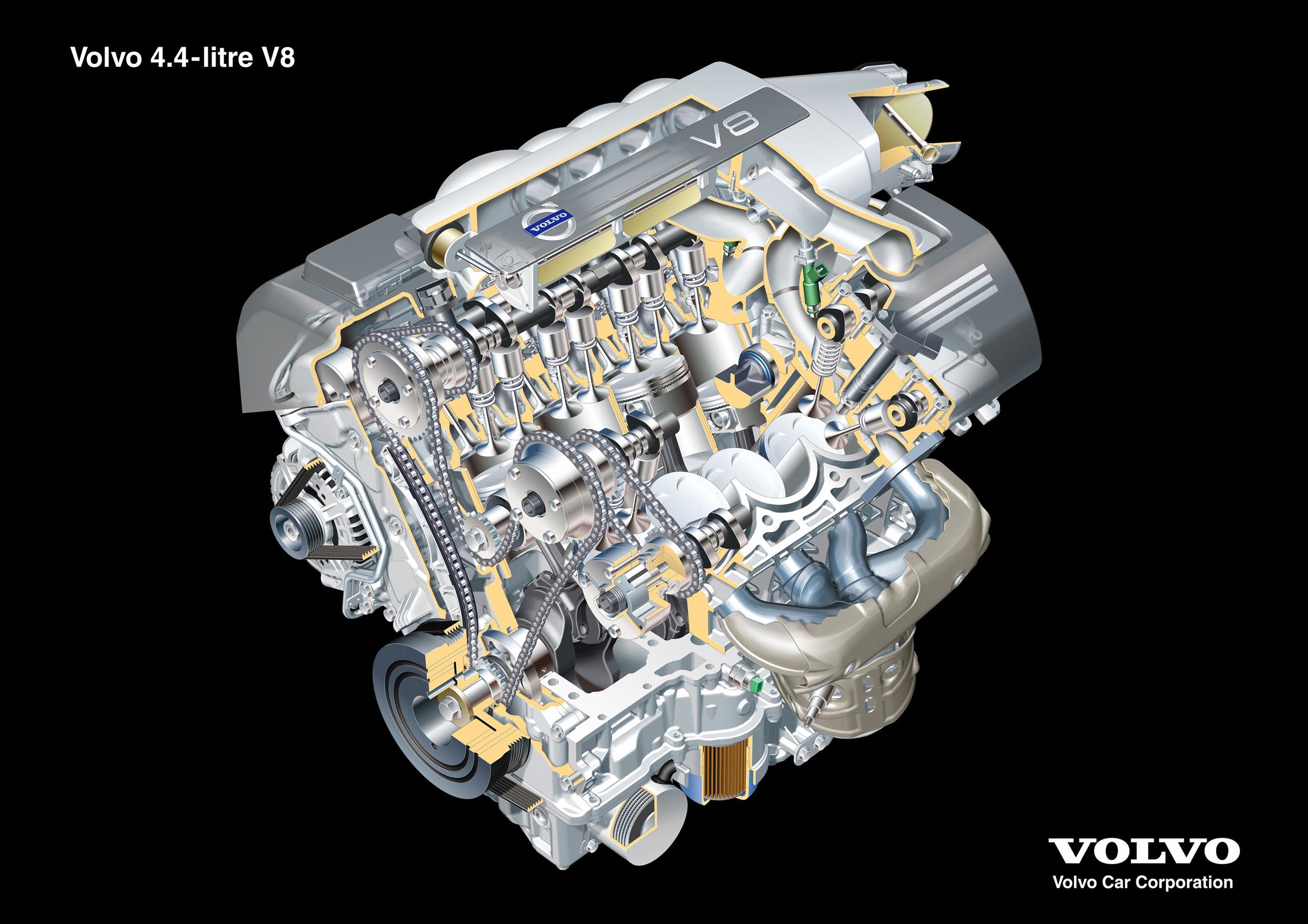Introduction
The Volvo B8444S was a 4.4-litre V8 petrol engine that was developed and manufactured by Yamaha Motor Corporation in Japan from early 2005 to August 2010. Key features of the B8444S engine included its:
- 94.0 mm bores and 79.5 mm stroke for a capacity of 4414 cc;
- Open-deck, high-pressure die-cast aluminium alloy cylinder block;
- Cast-in iron cylinder liners;
- 60 degree ‘V’ angle between the cylinder banks, with the left cylinder bank staggered ahead of the right cylinder bank;
- Counter-rotating balance shaft positioned within the engine’s ‘V’ between the cylinder banks;
- Aluminium alloy cylinder head;
- Chain-driven double overhead camshafts;
- Four valves per cylinder actuated by shimless tappets;
- Variable intake and exhaust valve timing with up to 40 degrees of adjustment for the intake and exhaust camshafts relative to the crankshaft;
- Variable intake manifold;
- Transverse mounting and compact dimensions (754 mm long and 635 mm wide);
Compression ratio of 10.4:1; - Variable-displacement A/C and power steering pumps; and,
- Dry weight of 190 kg.
The B8444S engine was mated to a six-speed Aisin Siki transmission.
While the B8444S engine produced peak outputs of 232 kW at 6000 rpm and 440 Nm at 3900 rpm, 370 Nm was available from 2000 rpm.
| Code | Engine | Power | Torque | Models |
|---|---|---|---|---|
| B8444S | 4414 cc petrol V8 | 232 kW at 6000 rpm | 440 Nm at 3900 rpm | Volvo XC90 V8, Volvo S80 V8 |
Development
Volvo foresaw that production of a V8 engine was necessary for its XC90 SUV to compete as a ‘luxury’ vehicle in the USA. However, a transversely mounted 90-degree V8 engine would not fit within the engine bay. At the direction of Ford Chief Technical Officer Richard Parry-Jones, Volvo engaged Yamaha to design a 60-degree V8 engine; Yamaha had previously supplied the first high-performance V6 engine for the Ford Taurus SHO (1989-95) and, subsequently, the 3.4-litre Ford SHO V8 engine that was produced from 1996-99. While the B8444S V8 engine had the same bore spacing and stroke as the 3.4-litre Ford SHO V8 engine, the B8444S engine is significantly different; for example, the B8444S engine has an open-deck rather than closed-deck block and the left cylinder bank is positioned ahead of the right cylinder bank.
Compact dimensions
Upon its release, Volvo claimed that the B8444S was the smallest V8 engine in a series production car. Unusually, the left cylinder bank was offset by half a cylinder ahead of the right bank so that the B8444S engine could fit into the ‘structural beam network’ of the Volvo XC90’s engine bay. While the intake camshafts were chain-driven from the crankshaft, the exhaust camshafts were driven by secondary chains from the inlet camshafts. Furthermore, the block of the B8444S was cast with built-in mounts for ancillary units such as the alternator and power steering pump; the starter motor was also fitted above the transmission.
Variable inlet manifold
The B8444S engine had a variable inlet manifold which featured a cross-over valve that would open between the left and right halves of the intake plenum when engine speeds exceed 3200 rpm. As such, the intake volume of the plenum increased at higher engine speeds for greater air flow; at lower speeds, the air flow between the two cylinder banks was cut off for a smaller inlet manifold and better air/fuel mixing.
Emissions control
The B8444S engine had four catalytic converters: two close-coupled catalytic converters that were mounted to each of the low-thermal-mass stamped sheet-metal exhaust manifolds and two additional catalytic converters mounted under the vehicle floor as part of the dual exhaust system.
Following cold starts, the B8444S engine:
- Had a high idling speed of about 1250 rpm;
- Used a lean air/fuel mixture for 15-20 seconds to minimise emissions until the catalytic converters reached operating temperature
Once the engine had warmed up, however, idle speed declined to 675 rpm.
Upon its release, the B8444S engine complied with ULEV-II emissions standards
Volvo XC90 V8 (B8444S): balance shaft bearing failure
The B8444S engine has a counter balance shaft in the engine’s ‘V’, between the cylinder banks. Washing the engine bay with water can cause water to accumulate between the cylinder banks and cause a sealed bearing which supports the balance shaft to corrode. Once the bearing fails or seizes, the bearing can begin to rotate within its housing and damage the engine casting. The main symptoms of bearing damage are unusual engine noises and rough running. To fix, the bearing needs to be replaced, though this requires the inlet manifold and at least one cylinder head to be removed for access.
If not repaired, the balance shaft will rattle and wear against the mount point on the opposite side where the timing chain is located. Eventually, the sprocket which drives the balance shafts can wear out, the timing chain can lose tension and this can affect the engine’s timing such that the pistons and valves may collide. If this occurs, Volvo’s repair procedure advises that the engine needs to be removed from the engine bay so that the cylinder heads can be removed – this makes repairs particularly expensive.
From engine no. 6833 (introduced in late 2005 or early 2006), two changes were made to avoid this problem:
- Drainage holes were introduced to the engine casting so that water would not accumulate in the vicinity of the bearing; and,
- An improved bearing was introduced.
AustralianCar.Reviews understands that Volvo has issued a technical bulletin advising dealers not to pressure wash or steam clean the B8444S engine due to this problem.













